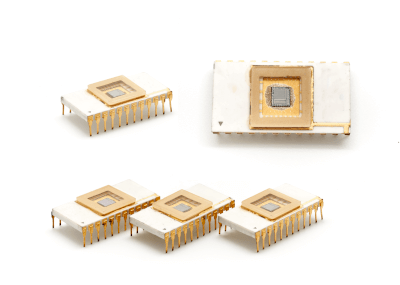What Is a PROM?

A PROM (Programmable Read Only Memory) is a type of semiconductor memory that is writable.
There are two main types of semiconductor memory: RAM (Random Access Memory), which can read and write, and ROM (Read Only Memory), which can only read.
RAM is a volatile memory that loses data when the power is turned off, while ROM is a nonvolatile memory that retains data even if the power is turned off.
There are two types of ROM: mask ROM and PROM. In mask ROM, the output value of the transistor for each bit of memory is fixed to either the supply voltage or ground during the semiconductor manufacturing process, so it cannot be changed after manufacturing.
In contrast, PROMs are nonvolatile ROMs developed to allow writing and rewriting after manufacturing.
Uses of PROMs
Microcontrollers used to control various devices have specific programs for each device and must operate upon power-on, so programs are stored in nonvolatile, low-cost ROMs.
Initially, mask ROMs were used as the primary type of ROM. However, the time from program finalization to manufacturing completion is long, making it difficult to respond to the shortened development cycles of new products.
Additionally, the need to produce a wide variety of products in small quantities due to the diversification of consumer needs has required the separate manufacturing of semiconductor chips.
In contrast, PROMs can be written even after the program has been debugged and finalized. This allows for the shortening of the development period by writing the program immediately before product shipment and for the development of new products by changing only the program.
Principles of PROMs
PROMs can be broadly classified into OTPROM (one-time PROM) and EPROM (erasable PROM). OTPROM is a type of PROM that can be written only once, while EPROM is a PROM that can be written multiple times.
1. OTPROM
OTPROM has a fuse for each bit of memory, and after shipment, some fuses are blown by selectively applying a high voltage. The transistor connected to the blown fuse, and the transistor connected to the unblown fuse have different current supplies, which distinguish between a0 and a1. A special tool is required for writing.
Once a fuse is blown, it cannot be restored, so it can only be written once.
2. EPROM
In EPROM, an electrically isolated region called a floating gate is formed in the manufacturing process in the transistor for each bit of memory. When writing, a voltage is selectively applied to the floating gate to store an electric charge, creating the difference between a0 and a1.
For rewriting, the memory charge in the target area is erased and then written again. There are UV-EPROM and EEPROM, depending on the erasure method.
UV-EPROM
UV-EPROM erases the charge by exposing the memory area to UV light (ultraviolet light). For this purpose, UV-EPROM has a window for UV light irradiation on the semiconductor package.
EEPROM
EEPROM allows data to be erased and rewritten by applying a higher voltage to the memory area than during normal read operations.
Other Information About PROMs
1. Expansion of Applications
The original use of PROMs was limited due to their high manufacturing cost. However, the use of PROMs has been expanding as their cost has decreased due to technological development and mass production.
In particular, flash memory (flash ROM), a type of EEPROM, has realized large capacity and high speed by simplifying the circuit to erase a large area of memory at once. The upper limit of rewritable cycles has been increased to several tens of millions, expanding applications that take advantage of its nonvolatility, and it is now used as a storage device in SD, USB, SSD, HDD, etc., becoming the mainstay of current memory technology.
2. Future Prospects
In the future, it is expected that non-volatile, low-cost memory with an unlimited number of rewrites will be put to practical use. Once this is realized, for example, PCs will no longer need to be started up and shut down, and can be used by simply turning the power on and off, as with lighting fixtures.